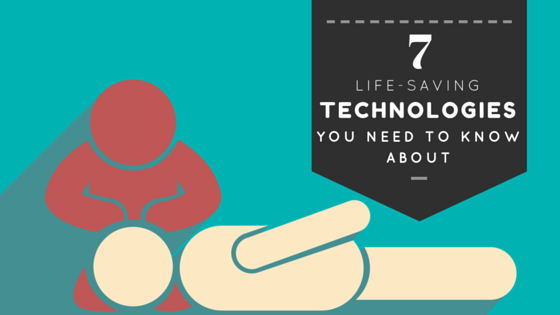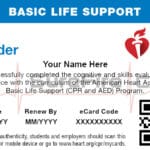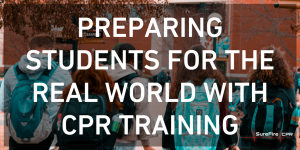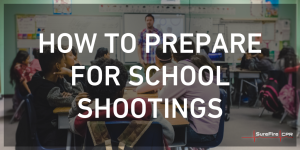
How can you save a life? Although many state-of-the-art technologies are available, first responders are committed to exploring and developing new tools they can use to become more productive and efficient day after day.
Today’s life-saving technology remains revolutionary, as it empowers even an ordinary individual to become a hero instantly. Meanwhile, new life-saving technologies are being developed that offer immense promise for bystanders and first responders as well.
Which innovative life-saving technologies could deliver long-lasting benefits? Here’s a closer look at seven life-saving technologies you need to know about:
-
PulsePoint
Anyone can be a superhero, and PulsePoint proves it by empowering men, women and children who are trained to perform cardiopulmonary resuscitation (CPR) to be alerted immediately when a cardiac emergency occurs, thanks to the PulsePoint Respond mobile app.
This one-of-a-kind app enables local public safety communications center, fire and EMS professionals to alert CPR-trained bystanders to someone nearby who is suffering cardiac arrest.
PulsePoint notes when CPR-trained bystanders receive an alert from PulsePoint Respond, it tells them where an cardiac arrest event is happening as well as where they can find the nearest automatic external defibrillator (AED).
Also, a PulsePoint spokesperson noted the app can help improve the survival of cardiac arrest victims by:
- Reducing collapse-to-CPR times by increasing citizen awareness of cardiac arrest events beyond a traditional “witnessed” area.
- Lowering collapse-to-defibrillation times by increasing awareness of public AED locations through real-time mapping of nearby devices.
- Providing a virtual window into fire and EMS activity in the community, offering a unique opportunity for civic engagement and transparency.
The app enables citizens to help before a life is in danger by identifying public access AEDs throughout a community. Within seconds, a user can place an AED location on a map, add business and descriptor information and submit photos of the AED in context of its environment.
With PulsePoint, users can comply with the most recent CPR guidelines issued by the American Heart Association (AHA) as well.
These guidelines recommend that communities “consider using social media and mobile app technology to alert CPR responders when someone nearby suffers sudden cardiac arrest,” PulsePoint says. The guidelines also cite studies that indicate emerging mobile technologies can result in a “higher rate of bystander-initiated CPR.”
“PulsePoint-connected communities don’t need to rely on the luck of having a CPR-trained citizen witness a cardiac arrest,” PulsePoint Foundation President Richard Price says. “By directly notifying those who are qualified and nearby, PulsePoint helps put the right people in the right place at the right time. PulsePoint builds on the good work that a community has done with CPR training and AED placement and improves the efficiency and use of these resources.”
The PulsePoint app is now connected to more than 1,500 communities in 24 U.S. states and is available in Canada and Australia. This app also has been adopted by nearly 75 percent of the state of California, and it has had more than 7,300 cardiac arrest activations with nearly 19,000 citizen responders to date.
For first responders, PulsePoint offers the potential to change patient outcomes significantly, both now and in the future. The app empowers CPR-trained citizens to find and assist cardiac arrest victims, ensuring these victims get the support they need quickly.
-
1st Minute
How can a first responder help a victim who speaks a different language? Unfortunately, language barriers may cause a first responder to miss out on critical information from a victim. But with 1st Minute, first responders and victims can eliminate such barriers altogether.
1st Minute reduces guessing by first responders and facilitates a relevant conversation between a first responder and victim in less time than ever before. In fact, the 1st Minute app usually enables first responders to translate a victim’s language in under a minute.
“[The app] is aligned with the next-generation first responder technology trends – apps on smartphones [and] tablets to help with communication,” a 1st Minute spokesperson says. “Also, a non-native traveler can use the app while in another country. It translates one’s medical or Apple Health ID and can relay symptoms to emergency rooms and pharmacists without the need for cell phone service or an Internet connection.”
1st Minute ensures first responders can overcome myriad challenges as well, including:
- Ensuring effective and timely responses to protect people and property.
- Having the ability to query databases to gain as much information as possible.
- Rapidly processing a flood of information and filtering out relevant data.
- Effectively communicating information about an event to the next level of care (medical facilities).
Thus far, 1st Minute users appear to be satisfied with the support they are receiving from this app – just consider some of the recent 1st Minute user feedback:
“The 1st Minute app from LanguageMAPS Inc. is the most useful and innovative new product that I have seen in the field of EMS in many years. It allows the EMS provider to quickly and accurately triage and treat patients that we were previously unable to communicate effectively with in the past. This asset greatly increases any organization’s capability in providing top-notch care to non-English speaking patients. I encourage all caregivers to add this app to their toolbox.” – EMS captain, North Texas
“1st Minute is not only a highly useful product, it will directly contribute to better patient outcomes in emergency situations.” – Paramedic, North Texas
Today, there are 300 million non-English speakers visiting the United States per year and 30 million already in the U.S. with very limited English speaking skills, 1st Minute notes. And during discussions with first responders in large cities, victims may speak languages like Vietnamese, Burmese, Chinese, Japanese and Korean, among others.
With 1st Minute, however, first responders can simply use their smartphones or tablets to translate a victim’s words and phrases without delay. And as a result, the app could provide exceptional benefits for first responders and victims for years to come.
-
Guardian by BackSafe Systems
Unfortunately, backing up a fire engine or ambulance remains a major challenge. But with Guardian by BackSafe Systems, firefighters and emergency medical services (EMS) professionals can reduce the risk of accidents and fatalities.
Guardian represents “a breakthrough communication tool for spotters and drivers that gives them the clarity, communication and visibility they need to avoid potential accidents, reduce liability and save lives,” according to BackSafe Systems. It boasts innovative handset and cab unit features, empowering the spotter and driver to communicate clearly and instantly at all times.
So how does Guardian work exactly? BackSafe Systems notes Guardian leverages “true position” technology that minimizes the need for hand signals and shouting, thus reducing the risk of miscommunication. And with “Stop” and “Go” LED lights, a handset safety trigger and digital event logs, Guardian helps users reduce accidents, prevent costly damage, and ultimately, save more lives.
Installing Guardian requires minimal resources, and typically, it can be installed in a vehicle within about an hour. Furthermore, Guardian offers support beyond what is available from traditional vehicle cameras and sensors, too.
“Cameras and sensors can notify a driver of proximity, but they are not predictive and often distract the driver from where his or her attention should be: the mirrors. Guardian by BackSafe Systems’ audible and visual cues make a spotter more effective and allow the driver to keep his or her eyes where they will ensure safe operation,” BackSafe Systems points out.
Take advantage of Guardian, and first responders can benefit from an all-inclusive app that streamlines emergency response.
-
Share911.com
Imagine what it would be like to have the ability to connect with first responders near your present location instantly. Now, you can, thanks to Share911.com.
Share911 provides instant two-way communication within an exclusive network such as first responders or school staff members. This technology empowers users to leverage their mobile devices or desktop computers to increase “situational awareness,” i.e. information that everyone involved in a crisis can provide to keep first responders up to date as a critical situation develops.
“Our mission is simple – to make help happen faster by leveraging workplace technology,” Share911 founder Eric Endress says. “Today, people who work in schools, stores, shopping centers, hi-rise buildings, industrial environments and virtually anywhere use Share911.com to let their co-workers know that they need help or if they are in danger. It also reduces the time it takes for police/fire/EMS personnel to respond to where help is needed. This saves lives.”
Share911 currently is sold almost exclusively to schools. But going forward, the technology could make rescue response more efficient in a variety of work environments.
In the future, Share911 could transform co-workers into first responders because it enables users to easily alert peers when they need help from any mobile device or computer. In addition, if an emergency is taking place in a work environment, police, fire and EMS personnel can utilize Share911 to see real-time reports of where help is needed.
“What if the people inside the building could use their mobile device to say ‘This is where I’m trapped’ or ‘This is where I’m injured’ or ‘This is where I saw the bad guy’?,” Endress tells The Asbury Park Press. “That would save a lot of time for police and firefighters to know where people are trapped or where the bad guy is.”
Share911 could serve as a game-changing life-saving technology. It empowers first responders and ordinary citizens alike, ensuring both parties can deliver and receive emergency support at any time.
-
Powderhook
Perhaps it’s only a matter of time before Powderhook becomes a top choice for first responders across the United States.
Powderhook today enables users to “communicate anonymously with people closest to you.” It frequently helps hunters connect with one another and share pictures, links, tips and other information in real-time.
But going forward, the app may prove to be incredibly valuable for first responders as well.
“Our app, Powderhook, allows users to anonymously ask a question of the 20 people closest to them who also have the app. Since we are targeted at the outdoor space, we believe we could eventually be a good safety mechanism. Imagine your boat is stranded, you can push notify 20 other people on the water,” a Powderhook spokesperson says.
With a mission of “Access for All,” Powderhook could transform the way first responders and victims connect with one another. The app enhances communication between both parties, ensuring these groups can interact with one another in real-time and provide ongoing updates.
-
Therapeutic hypothermia systems from Hypothermia Devices
American Nurse Today notes cardiac arrest outside the hospital results in roughly 250,000 deaths in the United States annually. Therapeutic hypothermia, however, enables medical professionals to reduce the temperature in those who fail to regain consciousness after cardiac arrest. As such, therapeutic hypothermia devices are being developed that could help cardiac arrest victims.
Today’s therapeutic hypothermia devices offer vital support to cardiac arrest victims, but these systems are continuously being upgraded. Many therapeutic hypothermia devices, for instance, are extremely bulky. But thankfully, a team of University of California, Los Angeles (UCLA) researchers is working toward reducing the size and enhancing the quality of therapeutic hypothermia systems.
Recently, these researchers formed Hypothermia Devices, a company that “designs and manufactures state-of-the-art cooling/heating devices for a wide range of medical applications, including therapeutic hypothermia.”
Hypothermia Devices’ first-rate systems are compact, portable, battery-operated and work at room temperature, the company says. And with Hypothermia Devices’ advanced cooling and heating systems, medical professionals could soon use these in ambulances as well as replace bulky therapeutic hypothermia equipment that currently takes up valuable real estate in hospitals and other medical facilities.
-
Lifetrend
In the past, a human-centered approach to healthcare was nearly impossible to find. However, Lifetrend has launched an app that offers users the ability to “engage with the healthcare system … to make hard medical decisions.”
“We’ve developed software for Google Glass and the Apple Watch that guides a health professional through the steps to resuscitate a patient,” Lifetrend co-founder Jim Lebret says.
The Lifetrend Advance Care Planning (ACP) app first identifies clients’ goals and values by enabling them to reflect on a range of attitudes about healthcare.
Then, the app gives users 15 medical decisions that are pre-answered based on the value statement they select. Clients can even override any of the pre-set answers, too.
Lastly, users and their witnesses sign the document – directly on a mobile device. Once the document is signed, it becomes legally binding, is securely stored on Lifetrend’s servers and will be made available to the right people at the right time in the right format.
The document also can be retrieved in a variety of ways, including:
- PDF print-outs
- Wallet cards with a QR code readable by an emergency medical technician (EMT)
- Through a hospital’s emergency medical records (EMR) interface
- On an individual’s own mobile device
The Lifetrend ACP app helps clinicians and patients “proactively choose an appropriate advanced directive by engaging patients’ values,” Lebret notes. This app ultimately may help both parties make more informed medical decisions as well.
What does the future hold for life-saving technologies?
The aforementioned technologies could transform the way first responders deliver emergency services. And over the next few years, these technologies could play important roles in reducing emergency response times and improving survival rates for victims, too.
But it’s crucial to remember the life-saving basics as well.
For example, anyone can become CPR certified. And by doing so, an individual can make a difference in the life of a cardiac arrest victim, particularly if they take advantage of the CPR and AED class from SureFire CPR.
SureFire CPR’s class for CPR and AED covers:
- Adult, child and Infant CPR
- How to use an AED and special considerations
- Conscious and unconscious choking for victims of all ages
Plus, SureFire CPR’s instructors are experts with direct current experience in the field of emergency intervention. They provide real-world insights while guiding a learning experience that is focused on each student. Therefore, these instructors always ensure students gain the skills and confidence they need to act in a crisis and feel comfortable with all CPR techniques.
And let’s not forget about SureFire CPR’s commitment to excellence, either.
SureFire CPR delivers professional, affordable and convenient CPR instruction to students throughout the Greater Southern California area. And at SureFire CPR’s industry-leading training facilities in Orange County and Riverside County, CPR classes and other certification programs are available to the public are and taught by professional firefighters, paramedics, lifeguards, ER nurses and EMTs. SureFire CPR even offers onsite training and CPR certification in Southern California for those who want to learn at their home or business.
Ready to become CPR certified? Contact SureFire CPR today at (888) 277-3143 or visit our website to learn more about CPR certification classes available across the Greater Southern California area.










